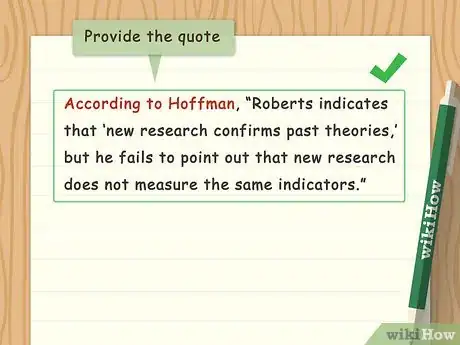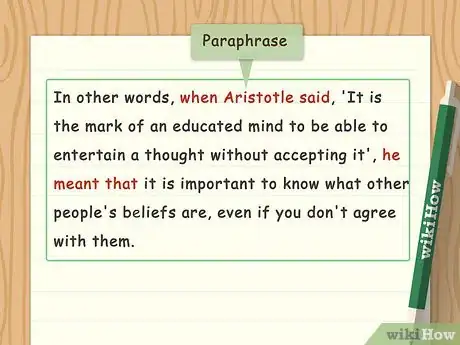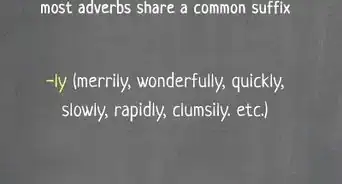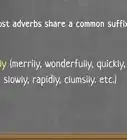This article was co-authored by Christopher Taylor, PhD. Christopher Taylor is an Adjunct Assistant Professor of English at Austin Community College in Texas. He received his PhD in English Literature and Medieval Studies from the University of Texas at Austin in 2014.
There are 7 references cited in this article, which can be found at the bottom of the page.
This article has been viewed 90,698 times.
Being thoughtful and accurate is the secret to a good analysis of a quote. Present the quote factually and be mindful of its broader context. Paraphrase the quote, which will convey your understanding of it. Break down elements of the writing style, and consider the importance of the quote to its audience.
Steps
Analyzing the Linguistic Style
-
1Point out figurative language. A quote, whether or written or spoken, will have a unique linguistic style and structure. Note the use of any figurative language (metaphors, similes, hyperbole, idioms, allusion, personification, and so on) that may add depth or a double meaning to the words. Such comparisons often make quotes more memorable and consequential.[1]
- As an example, you could write, “Hemingway used a blunt and dark metaphor when he said, 'Writing is easy. You just open a vein and bleed.'”
-
2Identify the tone of the quote. Show the impact and significance of a quote by outlining the spirit in which it was spoken or written. Elements like sarcasm may alter the true meaning of a quote, while negativity can intensify their message. Note the tone and mood of the quote, and mention if it is emblematic of the person who gave it.[2]
- You could also describe an author's tone as macabre, reverent, jaded, nostalgic, critical, arrogant, ironic, evasive, bitter, humble, caustic, earnest, whimsical, assertive, derisive, formal, impartial, enthusiastic, or patronizing, to name a few.
- For instance, you might identify the tone of a Dorothy Parker quote by saying, "With her typical tongue-in-cheek defeatism, Dorothy Parker wrote, 'Take me or leave me; or, as is the usual order of things, both'."
Advertisement -
3Note the use of alliteration. Alliteration is a literary tool that creates a musical effect in text and prose, making it enjoyable to recite and easy to memorize. This writing technique groups a number of words with the same first consonant sound closely together. Identify alliteration when analyzing a quote and comment on how it might have made the quote more memorable or recitable.[3]
- For instance, an analysis of a famous line from Romeo and Juliet might note that, "Shakespeare used alliteration in a memorable line that reads like a song: 'From forth the fatal loins of these two foes; a pair of star-cross'd lovers take their life.'"
Introducing the Quote
-
1Set up the quote. Before presenting the quote that you will be analyzing, provide a sentence or two that sets up its tone and importance. Give some indication of how the quote should be received by attributing a positive or negative value to it. If possible, show how the quote was received when it it was first spoken or written.[4]
- For instance, set up a negative quote by saying something like, "Critics of the group were vocal about their dismay."
- Situate a quote within a theme or phenomenon by saying something like, "The anti-vaccine movement has swept across the country in recent years."
-
2Introduce the source of the quote. Frame the quote within the context of who said it, when, and where. Provide the name of the individual who said it, and a bit of background about who they were and why they said it. Be sure to note when the quote was made and through what medium (e.g., in a book or speech).[5]
- For instance: "In his 1975 publication, 'Discipline and Punish: The Birth of the Prison', Michel Foucault had this to say about power, knowledge, and sexuality : [...]"
-
3Provide the quote. As a general rule, you should always present a quote in the same way as it was originally presented. Reproduce the spelling, internal punctuation, and capitalization of written quotes exactly, even if these elements are grammatically incorrect. If you are quoting a lecture, speech, or interview, make sure to get an accurate transcript to use from a library or reputable online archive. [6]
Explaining the Meaning
-
1Paraphrase the quote. Rephrase the quote in your own words to clarify what it means. Begin with a phrase like, "In other words," and present the quote in different terms to convey what the author meant. Be sure to avoid straying from the original meaning.[7]
- For example, say, "In other words, when Aristotle said, 'It is the mark of an educated mind to be able to entertain a thought without accepting it', he meant that it is important to know what other people's beliefs are, even if you don't agree with them."
-
2Establish the quote's significance. Link the quote to a greater significance, movement, theme, motif, or theory to justify why you've analyzed it. Be concise and convey this importance in no more than 2-3 sentences. Include a breakdown of how the quote affected its audience (e.g., by introducing a new idea or by inciting an emotional response).[8]
- For instance, write something like, “This quote from Churchill, as part of a stirring speech that inspired Britain, encapsulates his role in boosting morale during the war.”
-
3Relate the quote to current events or ideas. Establish the lasting effect of a quote by demonstrating how it is still relevant today, beyond its immediate context. Look for parallels between different historical eras. Offer a theory for why the words have resonated over time.[9]
- For example, you might connect the Winston Churchill quote, "Healthy citizens are the greatest asset any country can have", to current-day debates about healthcare.
References
- ↑ http://slc.berkeley.edu/quote-analysis-easy-way
- ↑ http://slc.berkeley.edu/quote-analysis-easy-way
- ↑ https://liberalarts.oregonstate.edu/wlf/what-alliteration
- ↑ https://www.antioch.edu/santa-barbara/wp-content/uploads/sites/4/2016/12/WRITING-CENTER_1.-Tips-for-Integrating-Quotations-final.pdf
- ↑ https://www.antioch.edu/santa-barbara/wp-content/uploads/sites/4/2016/12/WRITING-CENTER_1.-Tips-for-Integrating-Quotations-final.pdf
- ↑ https://poorvucenter.yale.edu/sites/default/files/files/Working%20with%20Quotations%203%20-%20Analysis.pdf
- ↑ https://writingctr.rutgers.edu/blog/161-5-steps-to-quote-analysis
- ↑ http://writingcenter.unc.edu/handouts/quotations/
- ↑ http://slc.berkeley.edu/quote-analysis-easy-way
About This Article
If you need to analyze a quote, start by introducing the context of the quote, including relevant information about the author, the historical period, and any other significant details, like whether the quote came from a book or a speech. Present the quote in its entirety, then restate it in your own words. Follow that by explaining why you think the quote is significant. Also, point out any figurative language in the quote that reinforce your interpretation, like metaphors, hyperbole, or idioms. Keep reading to learn tips from our Writing co-author on how to relate the quote to current events!




































































